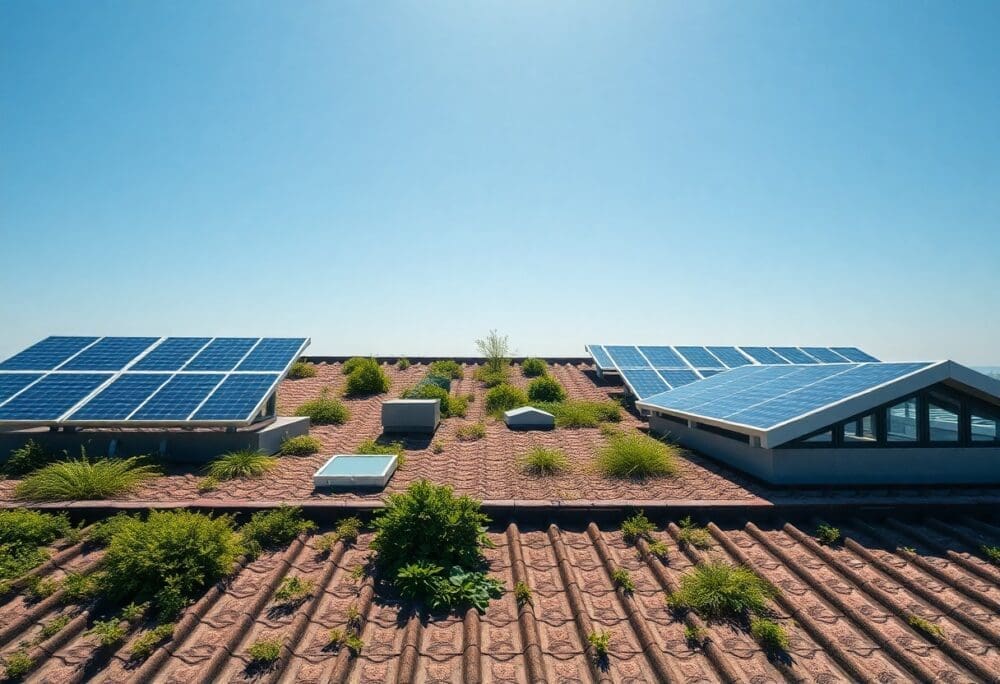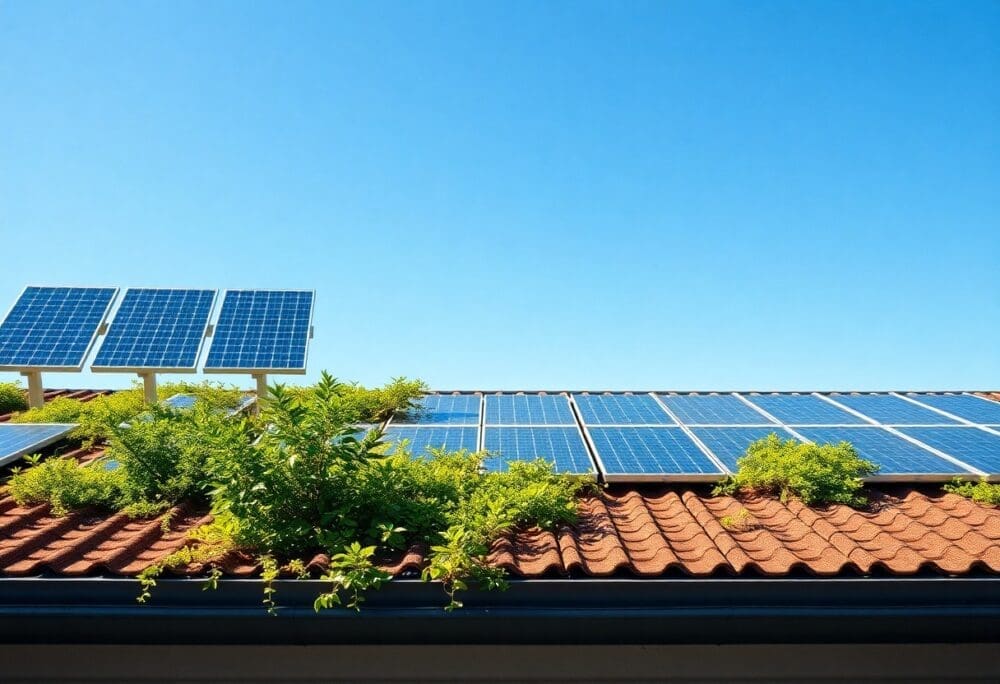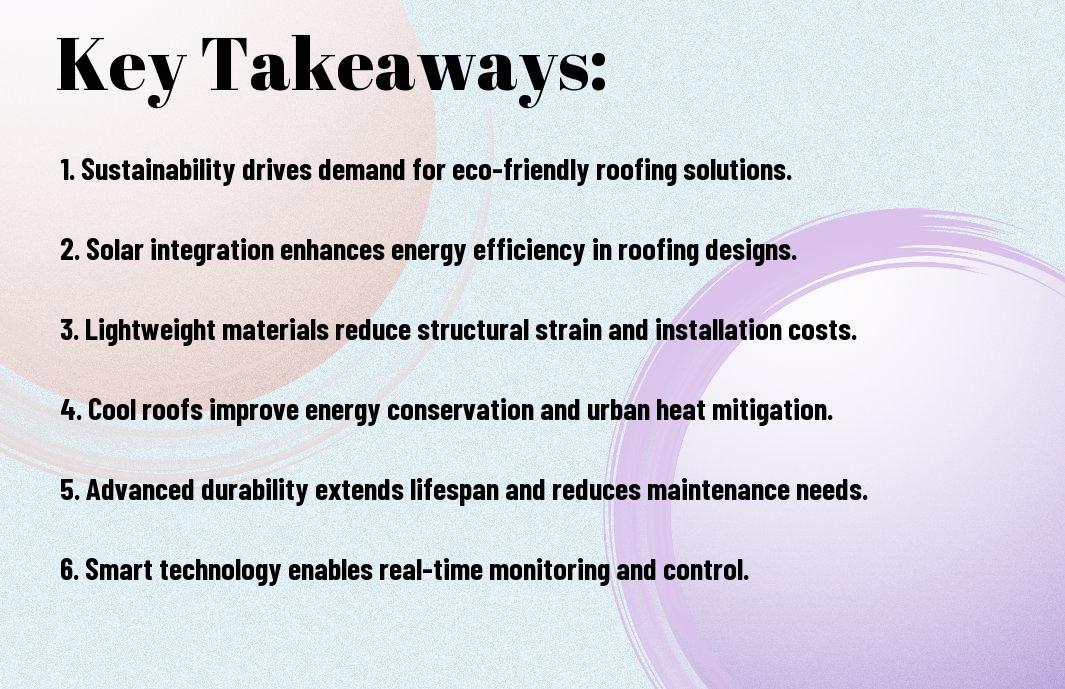It’s crucial to stay informed about the evolving landscape of roofing materials as they play a vital role in sustainability, energy efficiency, and aesthetics. As you explore innovative options, you’ll discover an array of advanced materials designed to enhance the resilience and performance of your roofing systems. From solar shingles to eco-friendly options, these innovations are not only transforming the way we think about roofs but also significantly impacting your home’s energy consumption and overall value. Join us as we research into the exciting trends shaping the future of roofing materials.
Key Takeaways:
- Emerging roofing materials such as solar tiles and green roofs are promoting sustainability, enhancing energy efficiency, and reducing urban heat island effects.
- Advancements in materials technology, including lightweight composites and self-healing materials, are increasing the durability and longevity of roofing systems.
- The integration of smart technology in roofing solutions is allowing for real-time monitoring and maintenance, contributing to a more proactive approach in building management.
Overview of Traditional Roofing Materials
Before exploring the innovative materials shaping today’s roofing industry, it’s important to understand traditional roofing options that have served buildings for decades. These materials, prized for their durability and availability, form the baseline from which new technologies are evolving. Familiarizing yourself with these will provide context for the innovations emerging in the market.
Common Types of Roofing Materials
Below is a concise overview of the most popular traditional roofing materials:
| Material | Characteristics |
| Asphalt Shingles | Cost-effective, versatile, and easy to install. |
| Metal Roofing | Long-lasting, energy-efficient, and resistant to extreme weather. |
| Clay Tiles | Durable, fire-resistant, and aesthetically pleasing. |
| Slate | High-end, durable, and offers unique visual appeal. |
| Wood Shakes | Natural look, effective insulation, can require maintenance. |
The traditional roofing materials each offer unique benefits tailored to different architectural styles and climates.
Limitations of Conventional Options
Across the roofing landscape, conventional options often come with their own set of challenges. While these materials provide basic protection and have established performance records, they may fall short in meeting evolving demands for sustainability, energy efficiency, and adaptability to climate change.
But as you consider roofing options, be aware that traditional materials can lead to issues like increased energy consumption, limited lifespan, and higher long-term maintenance costs. As environmental concerns rise and technology advances, you might find that these conventional choices don’t align with modern needs. Exploring alternatives could offer enhanced performance and better sustainability for your roofing projects.
Emerging Innovative Roofing Technologies
Even in a rapidly advancing world, innovative roofing technologies are transforming the industry, offering sustainable solutions and enhanced performance. From solar integration to eco-friendly materials, these technologies provide homeowners with options that not only look appealing but also contribute to energy efficiency and environmental wellness. Staying informed about these developments allows you to make better choices when upgrading or installing your roof.
Solar Roofing Solutions
Technologies focused on solar roofing solutions have surged in popularity, providing homeowners with the ability to harness renewable energy directly from their rooftops. This integration not only generates power but can significantly reduce energy bills, making your home more self-sufficient and environmentally friendly.
Green Roof Systems
Across urban landscapes, green roof systems are gaining traction as a sustainable roofing option that provides numerous environmental benefits. These systems involve the installation of vegetation on rooftops, which helps to improve air quality, reduce heat absorption, and manage stormwater runoff effectively.
Understanding the mechanics of green roof systems can lead to a multitude of advantages for your home. By promoting biodiversity and enhancing urban aesthetics, these roofs offer significant insulation benefits, which can lower your heating and cooling costs. Additionally, they absorb rainwater, reducing runoff and alleviating pressure on your drainage system. Installing a green roof not only supports a diverse ecosystem but also contributes to a more sustainable urban environment.
Impact of Climate Change on Roofing Materials
Despite the challenges posed by climate change, roofing materials are evolving to meet new environmental demands. Increased temperature fluctuations, severe weather events, and rising sea levels are influencing the development of more resilient and energy-efficient materials. You must consider how these factors not only affect the longevity and performance of roofing systems but also the overall sustainability of your building projects.
Resilience and Durability Considerations
An understanding of resilience and durability in roofing materials is imperative for today’s building standards. You should look for options that can withstand extreme weather conditions, including high winds and heavy rainfall, ensuring that your roofing system serves you well over time. Selecting materials that incorporate advanced technologies can significantly enhance the longevity of your roof.
Sustainable Practices in Roofing
Before choosing roofing materials, evaluate the sustainability aspects that will benefit both your project and the environment. By opting for eco-friendly products, you not only lower your carbon footprint but also promote healthier living spaces. Your choice can contribute to energy efficiency and reduced waste in the construction process.
Impact extends beyond immediate installations, as sustainable roofing practices pave the way for innovative materials that reduce energy consumption and promote recycling. You can select options like cool roofs, solar tiles, and recycled materials that mitigate environmental impact while enhancing your property’s energy efficiency. Engaging in these sustainable practices not only positions you as a responsible builder but also ensures that you are prepared for future challenges posed by climate change.
Aesthetic Trends in Roofing Designs
Not only functionality defines modern roofing, but aesthetic trends are embracing vibrant designs. As you explore innovative materials, you’ll find an array of options that cater to your personal taste, from sleek contemporary styles to classic aesthetics. Enhanced colors and textures will transform your roof into a statement piece, ensuring your home stands out while maintaining architectural harmony.
Color and Texture Innovations
One of the most exciting advancements in roofing is the innovative use of color and texture. You can now select roofing materials that offer a variety of hues, patterns, and finishes, allowing you to personalize your home’s appearance. These innovations not only elevate your home’s curb appeal but also provide lasting durability and protection from environmental factors.
Integration with Architectural Styles
With the evolution of roofing materials, seamlessly integrating your roof’s design with your overall architectural style has become simpler than ever. Options are available that complement modern, traditional, and even eclectic designs, enabling you to achieve cohesive aesthetics. Whether you lean towards minimalism or ornate details, these innovative materials align perfectly, creating a harmonious look that enhances your property’s overall charm.
The integration of roofing styles with architectural features is necessary for achieving a unified design. You’ll find versatile materials that mimic the look of natural products or align with contemporary themes, giving your home a polished, tailored appearance. Architectural shingles, for instance, provide the look of wood or slate without the associated maintenance, ensuring your roof contributes to the architectural narrative you envision. This alignment between your roof and your home’s structure not only enhances visual appeal but also increases property value by demonstrating thoughtful design choices.
Cost-Benefit Analysis of Innovative Roofing
To navigate the vast array of roofing materials, it’s vital to conduct a thorough cost-benefit analysis. Evaluating the initial investment against the long-term benefits helps you identify materials that offer both durability and energy efficiency. These advancements not only enhance your property’s aesthetic appeal but also contribute to significant savings on energy bills, maintenance costs, and potential resale value. Understanding these factors ensures you make an informed decision tailored to your budget while maximizing home performance.
Initial Investment vs. Long-term Savings
An effective roofing strategy begins with weighing the initial investment against the prospective long-term savings. While innovative materials may come with a higher upfront cost, their durability and energy efficiency can lead to substantial savings on repairs, utility bills, and increased lifespan. By considering these long-term benefits, you can better appreciate the value that modern roofing solutions bring to your property.
Value Addition to Properties
Investment in innovative roofing materials not only improves energy performance but also enhances your property’s overall market value.
In addition to the aesthetic upgrades and durability, innovative roofing significantly contributes to energy efficiency, which can be a major selling point for potential buyers. Features such as cool roofing or solar-integrated shingles enhance your home’s energy performance, thus appealing to those looking for sustainability. Moreover, a visually appealing roof can boost curb appeal and draw in higher offers, making it a worthwhile investment if you consider selling in the future. As buyers increasingly seek energy-efficient homes, your investment in innovative roofing can pay off both functionally and financially.
Case Studies of Innovative Roofing Projects
Many exciting roofing projects are pushing the boundaries of innovation, showcasing sustainable solutions and design excellence. Here are a few notable case studies that illustrate these advancements:
- The Edge, Amsterdam: Features a green roof that reduces energy consumption by up to 50%.
- Bosco Verticale, Milan: Utilizes solar panels integrated into the façade and rooftop, generating 20% of its energy needs.
- One Central Park, Sydney: Known for its sky gardens that improve air quality and biodiversity, combining aesthetics with sustainability.
- AT&T Stadium, Arlington: Boasts a retractable roof made of ETFE, which enhances natural light while providing weather protection.
Successful Implementations
Between 2015 and 2023, numerous projects have successfully implemented innovative roofing solutions, resulting in increased energy efficiency and improved environmental impacts. For instance, many commercial buildings have adopted reflective roofing materials that significantly reduce heat absorption, often yielding a 30% reduction in cooling costs. Your choice to adopt such technologies can lead to substantial savings and a reduction in your environmental footprint.
Lessons Learned and Best Practices
With each innovative roofing project, valuable insights are gained that can guide future implementations. Key factors for success include collaboration with specialists, thorough planning, and consideration of local climate conditions to select suitable materials. As you explore roofing innovations, understanding these lessons can help you avoid common pitfalls and maximize your project’s potential.
Due to the diverse range of innovative roofing applications, it becomes important to analyze outcomes from both successes and failures. Engaging early stakeholders, conducting feasibility studies, and embracing flexibility in design can greatly enhance your project’s viability. You should also prioritize sustainable materials and practices to align with global environmental trends. Adopting these best practices will not only elevate your project’s success but will also contribute positively to your community and the environment.
Final Words
Following this exploration of innovative roofing materials, you can see how advancements are shaping future trends in the industry. By staying informed about the latest options, from sustainable to high-performance materials, you can enhance your home’s resilience and energy efficiency. Embracing these innovations not only adds value to your property but also ensures that you are prepared for the evolving landscape of roofing solutions. Your choice today can significantly impact your home’s performance and aesthetic appeal for years to come.
Q: What are some examples of innovative roofing materials currently being developed?
A: Innovative roofing materials include a variety of high-performance options that focus on sustainability, energy efficiency, and durability. Some examples are solar shingles, which integrate photovoltaic cells into traditional roofing materials, allowing for energy generation; green roofs, which utilize vegetation to improve insulation and reduce urban heat; and reflective shingles designed to reflect sunlight, thereby lowering cooling costs. Additionally, advanced materials like synthetic slate and tiles made from recycled materials contribute to both aesthetic appeal and environmental benefits.
Q: How do advanced roofing materials contribute to energy efficiency?
A: Advanced roofing materials contribute to energy efficiency in several ways. Reflective roofing materials are designed to reflect solar radiation, which helps lower building temperatures and reduce the demand for air conditioning. Green roofs provide insulation and can manage stormwater, decreasing the heat island effect in urban areas. Furthermore, materials with high thermal mass can absorb and store heat during the day, releasing it at night, which moderates indoor temperatures. By utilizing these innovative materials, homeowners can significantly reduce their energy consumption and costs over the lifespan of their roofs.
Q: What future trends can we expect in roofing material technology?
A: Future trends in roofing material technology are likely to focus on greater sustainability, flexibility, and smart integration. Advances in manufacturing processes may lead to more eco-friendly materials, minimizing waste and leveraging recycled products. There will also be a push towards dynamic roofing systems that can change properties based on weather conditions, such as materials that can adjust their insulation level. Additionally, integration with smart technology, including sensors that monitor conditions and optimize energy use, is expected to grow. As environmental awareness increases, the emphasis on sustainable practices in roofing will remain at the forefront.






